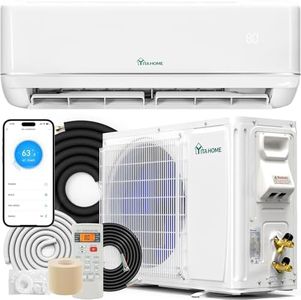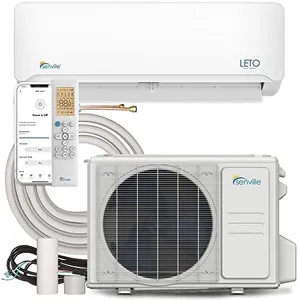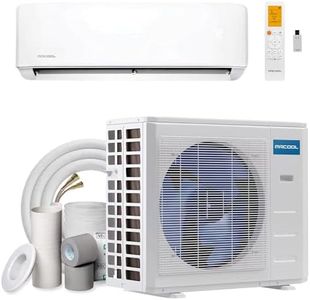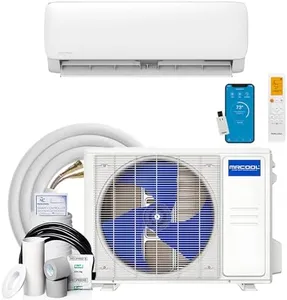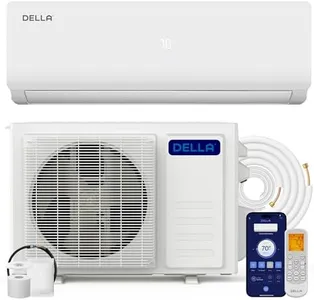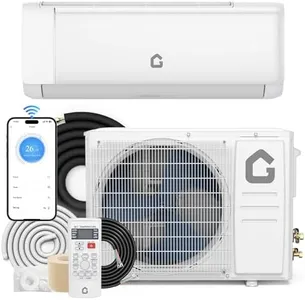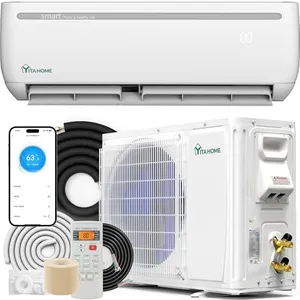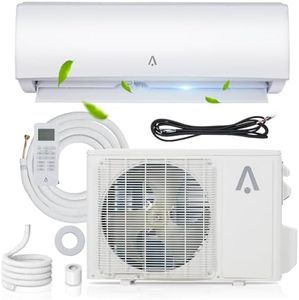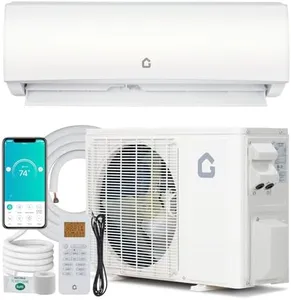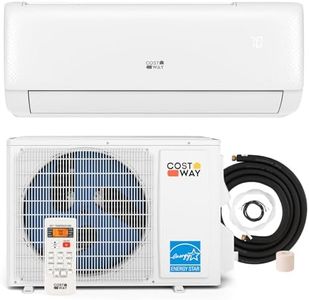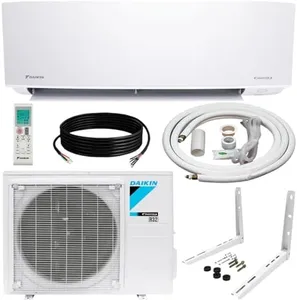10 Best Mini Split Heat Pumps 2025 in the United States
Our technology thoroughly searches through the online shopping world, reviewing hundreds of sites. We then process and analyze this information, updating in real-time to bring you the latest top-rated products. This way, you always get the best and most current options available.

Our Top Picks
Winner
Senville LETO Series Mini Split Air Conditioner Heat Pump, 18000 BTU 208/230V, Inverter, Works with Alexa, SEER2 19, 1.5 Ton, White
Most important from
7283 reviews
The Senville LETO Series Mini Split is a solid choice for heating and cooling a medium-sized space, around 1000 square feet. With an 18,000 BTU capacity (1.5 tons), it comfortably manages typical rooms or small homes. Its SEER rating of 19 indicates strong energy efficiency, helping reduce electricity bills compared to older models. Although a specific HSPF rating is not provided, its inverter technology ensures smooth power adjustment, maintaining steady temperatures and lowering energy waste. A standout feature is Alexa compatibility, enabling control via voice commands or smartphone app, adding convenience.
With a low noise level of 30 decibels, this mini split operates quietly in environments like bedrooms or offices. It supports one zone, ideal for precise control of a single area rather than multiple rooms. The system includes useful functions such as a dehumidifier and fan mode and can operate in winter temperatures down to 5°F (-15°C), making it versatile throughout the year. Installation requires a professional since the unit comes fully pre-charged but needs proper setup for optimal performance.
Although it is not Energy Star certified, which might be a consideration if the highest environmental standards are desired, it comes with a 5-year warranty on the compressor and parts, providing good peace of mind. This system suits homeowners or small business owners looking for a quiet, smart, and efficient mini-split solution for one main area without complex multi-zone requirements.
Most important from
7283 reviews
Senville LETO Series Mini Split Air Conditioner Heat Pump, 9000 BTU 110/120V, Inverter, Works with Alexa, SEER2 21.5, White
Most important from
7283 reviews
The Senville LETO Series Mini Split Air Conditioner Heat Pump is a versatile solution for anyone looking to maintain comfortable temperatures year-round. With a BTU capacity of 9000, it's effective for spaces up to 400 square feet, making it ideal for bedrooms, small living areas, or commercial spaces like cafes and shops. One of its notable strengths is the impressive SEER rating of 21.5, which indicates high energy efficiency, helping to reduce energy bills over time. The system also boasts a low noise level of just 25 dB, ensuring quiet operation—a must for residential settings.
The inverter technology allows for smooth and efficient temperature control, automatically adjusting based on the needs of the environment. Additionally, the ability to connect with Alexa provides convenient voice control, letting users manage their heating and cooling from anywhere, which adds to its modern appeal.
On the downside, this mini-split system requires professional installation, which could be a drawback for those looking for a straightforward DIY project. While it does come with a comprehensive installation kit, having to hire a professional might increase costs. The warranty terms are also something to consider; while parts have a two-year warranty and the compressor five years, labor is not included, potentially leading to additional expenses if service is required. Lastly, it’s worth noting that this unit is not Energy Star compliant, which might be a concern for those prioritizing eco-friendly appliances.
Most important from
7283 reviews
MRCOOL DIY 12,000 BTU Ductless Mini Split Air Conditioner & Heat Pump, 115V 5th Generation WiFi Smart Control AC & Heater w/ Remote & Quiet Operation
Most important from
203 reviews
The MRCOOL DIY-12-HP-WM-115D25O mini-split heat pump is a strong choice for efficiently heating and cooling medium-sized rooms around 350-550 sq ft. It offers 12,000 BTU capacity, making it suitable for single-zone use in spaces like bedrooms, home offices, or small living areas. With an impressive 23.5 SEER2 rating and a 10.2 HSPF, it delivers excellent energy efficiency, helping keep electricity bills lower compared to less efficient models. The noise level of 45 dB is about as quiet as a normal conversation, which should be comfortable for most indoor environments but might be noticeable in very quiet rooms.
One of its standout features is the easy DIY installation thanks to the pre-charged refrigerant lines and straightforward setup that doesn’t require professional tools or training, ideal for handy homeowners looking to avoid extra installation costs. The unit uses variable-speed inverter technology, which adjusts compressor speed for better temperature control and energy savings. It also supports smart features like WiFi control through an app, compatible with Alexa and Google Assistant, allowing convenient remote operation.
This unit is limited to a single zone, so it’s not a fit if you want to cool or heat multiple rooms separately. Also, while it has a solid warranty and advanced features, the 115V power requirement means it’s best suited for standard home electrical setups but may not support larger capacity needs. The MRCOOL mini-split provides reliable, energy-efficient comfort with user-friendly installation and smart controls, making it a practical pick for single-room applications.
Most important from
203 reviews
Buying Guide for the Best Mini Split Heat Pumps
Mini-split heat pumps are an excellent choice for heating and cooling individual rooms or small spaces. They are energy-efficient, easy to install, and provide precise temperature control. When choosing a mini-split heat pump, it's important to consider several key specifications to ensure you select the best fit for your needs. Understanding these specifications will help you make an informed decision and ensure that the unit you choose will effectively and efficiently meet your heating and cooling requirements.FAQ
Most Popular Categories Right Now
